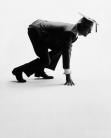The Articles
The Articles :
The adjectives A (or AN) and THE are called articles.
The definite article THE points out one or more particular objects as distinct from others of the same kind.
1. The train is late.
2. Here is the key.
3. The children are in the next room.
2. The indefinite articles a (or an) designate an object as merely one of a general class or kind.
1. Lend me a pencil.
2. I have a cold.
3. A young man answered my knock.
The article A is a fragment of ĀN (pronounced ahn), the ancient form of the numeral one.
AN keeps the n which A has lost.
THE is an old demonstrative, related to that.
THE with a singular noun sometimes indicates a class or kind of objects.
1. The scholar is not necessarily a dry as dust.
2. The elephant is the largest of quadrupeds.
3. The aeroplane is a very recent invention.
4. Resin is obtained from the pine.
Note : In this use THE is often called the generic article (from the Latin genus - kind or sort). The singular number with the generic THE is practically equivalent to the plural without an article. Thus in the first example the sense would be the same if we had - Scholars are not necessarily dry as dusts.
An adjective preceded by THE may be used as a plural noun.
1. The brave are honored.
2. The rich have many cares.
3. The strong should protect the weak.
AN is used before words beginning with a vowel or silent h.
A is used before other words.
Thus….
1. an owl
2. an apple
3. an honest man
4. a stone
5. a pear
Special rules for A or AN are the following.
1. Before words beginning with the sound of y or w, the form A, not AN, is used.
Examples :
1. a union
2. a university
3. a yew
4. a ewe
5. a eulogy
6. a Utopian scheme
7. such a one
This rule covers all words beginning with eu and many beginning with u. Note that the initial sound is a consonant, not a vowel. AN was formerly common before such words (as….an union, such an one). But A is now the settled form.
2. Before words beginning with h and not accented on the first syllable, AN is often used. Thus, we say….
a his´tory…..BUT, an histor´ical novel
In such cases, the h is very weak in sound and is sometimes quite silent, so that the word practically begins with a vowel. Usage varies, but careful writers favor the rule here given. AN was formerly more common before h than at present.
With two or more connected nouns or adjectives the article should be repeated whenever clearness requires.
1. I have consulted the secretary and the treasurer. [“The secretary and treasurer" would imply that the same person held both offices.]
2. I found an anchor and a chain. [“An anchor and chain" would suggest that the chain was attached to the anchor.]
3. In some towns there are separate schools for the boys and the girls. In others the boys and girls attend the same schools.
4. He waved a red and white flag.
5. He waved a red and a white flag.
A is often used distributively, in the sense of each.
1. I paid five dollars a pair for my shoes.
2. The letter-carrier calls twice a day.
3. My class meets three times a week. In such phrases A is better than per, except in strictly commercial language.
When used with adjectives, the articles precede, except in a few phrases such as….
1. Such an uproar was never heard.
2. Many a man has tried in vain.
The Articles :
The Articles To HOME PAGE
